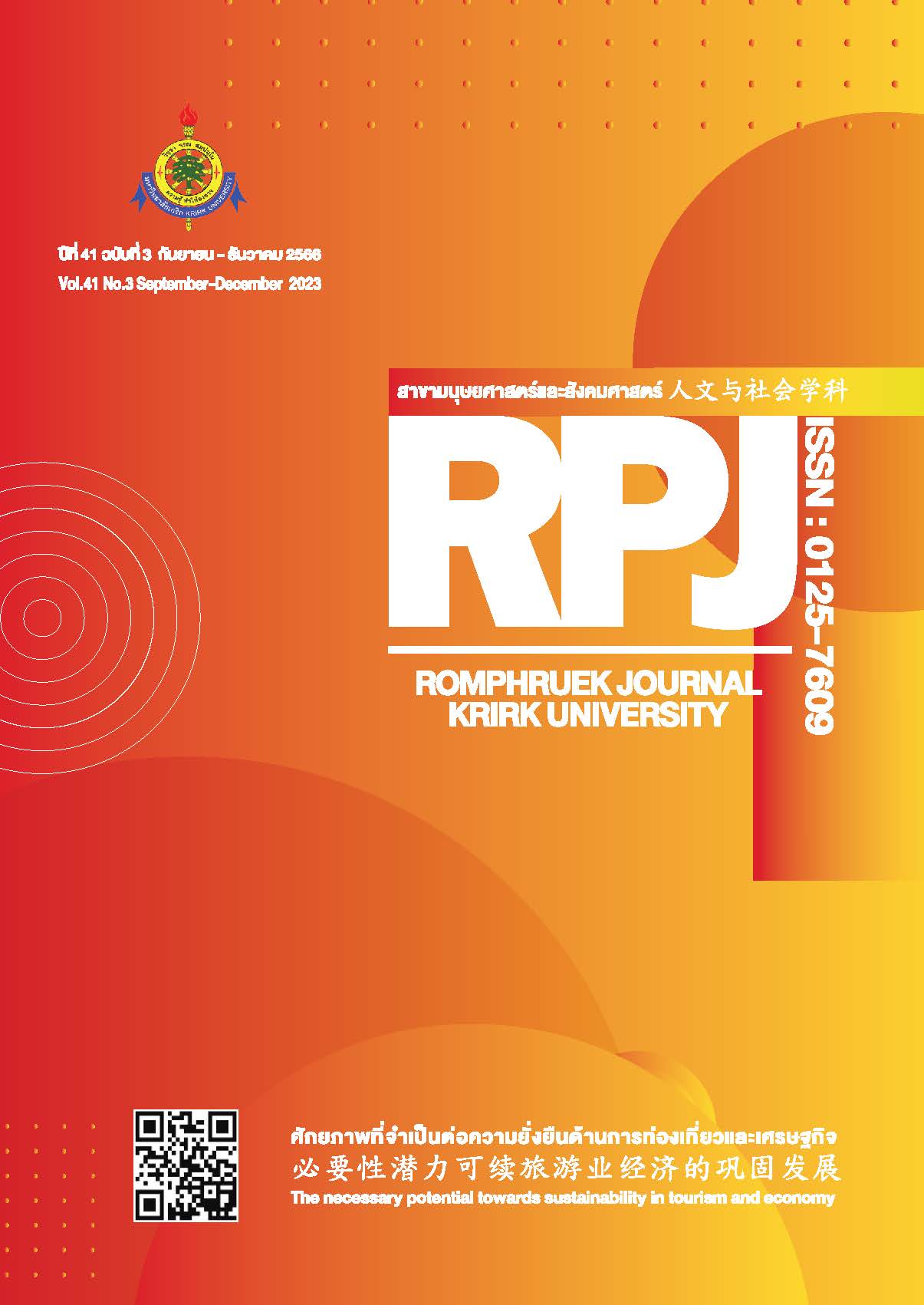The Influence of Perception, Attitude and Behavior Affecting to Gastronomic Tourism Decisions of Thai Tourists in Phuket
Main Article Content
Abstract
The research aimed to examine the level of perception, attitude, and behavior affecting to gastronomic tourism decisions of Thai tourists in Phuket and to investigate the influence of perception, attitude, and behavior affecting to gastronomic tourism decisions of Thai tourists in Phuket. The samples for this study were 400 Thai tourists traveling to Phuket to taste the local food, chosen by stratified sampling method and the convenient random sampling method, respectively. The research tool was the questionnaires. The data were analyzed by mean, standard deviation, and Multiple Linear Regression Analysis. The results found that 1) In terms of the overall level of perception, attitude and behavior affecting the respondents’ gastronomic tourism decision to Phuket, the overall level of perception and behavior were found at a moderate level, while the overall level of attitude was at a high level. 2) Perception had an influence on gastronomic tourism decisions at the statistically significant level .01 3) Attitude had an influence on gastronomic tourism decisions at the statistically significant level .01 4) Behavior had an influence on gastronomic tourism decisions at the statistically significant level .01
Article Details

This work is licensed under a Creative Commons Attribution-NonCommercial-NoDerivatives 4.0 International License.
Every article published in the Romphruek Journal of the Humanities and Social Sciences is the opinion and point of view of the authors. Thery're not the viewpoint of Krirk University or the editored department. Any part or all of the articles for pablication must be clearly cited.
References
กชกร จุลศิลป์. (2561). กลยุทธ์การจัดการการตลาดเพื่อส่งเสริมการท่องเที่ยวเชิงอาหารของนักท่องเที่ยวชาวไทยในจังหวัดพระนครศรีอยุธยา (วิทยานิพนธ์ปริญญามหาบัณฑิต ไม่ได้ตีพิมพ์). สถาบันบัณฑิตพัฒนบริหารศาสตร์.
กฤชณัท แสนทวี. (2562). แนวทางการสร้างภาพลักษณ์ประเทศไทยสู่การเป็นแหล่งท่องเที่ยวเชิงอาหารในกลุ่มประเทศสมาชิกอาเซียน. วารสารวิชาการนวัตกรรมสื่อสารสังคม, 7(2), 59-70.
กฤตวิทย์ กฤตมโนรถ และ ศุภกรณ์ ดิษฐพันธุ์. (2562). การท่องเที่ยวเชิงอาหารผ่านอัตลักษณ์อาหารทั้ง 4 ภูมิภาค. วารสารสถาบันวัฒนธรรมและศิลปะ มหาวิทยาลัยศรีนครินทรวิโรฒ, 20(2), 139-151.
คมสิทธิ์ เกียนวัฒนา. (2559). การเลือกให้ความสนใจต่อสื่อที่มีผลต่อการตัดสินใจท่องเที่ยวประเทศไทยเทียบกับประเทศคู่แข่งในอาเซียนของชาวจีนวัยผู้ใหญ่ตอนต้น. วารสารวิจัยสหวิทยาการไทย, 11(4), 8-14.
ฉวีวรรณ ศรีดาวเรือง จิราพร วรวงศ์ อัจฉราวดี ศรียะศักดิ์ จุฬารัตน์ ห้าวหาญ และพรพรรณ มนสัจจกุล. (2563). ความสัมพันธ์ระหว่างความรู้ ทัศนคติ และพฤติกรรมการบริโภคอาหารและการออกกำลังกายของผู้ใหญ่วัยกลางคนที่มีภาวะน้ำหนักเกินในชนบท. วารสารศูนย์อนามัยที่ 9, 14(35), 464-482.
ชลิดา แย้มศรีสุข จีรณา จินดาพล และอัญญาณี ลีลา. (2563). กระบวนการกลายเป็นสินค้าของอาหารพื้นเมือง: ภูเก็ตสู่การท่องเที่ยวเชิงวัฒนธรรมอาหาร. วารสารวิทยาลัยสงฆ์นครลำปาง, 9(1), 144-145.
ดารณี พานทอง. (2542). ทฤษฎีการจูงใจ. มหาวิทยาลัยรามคำแหง.
นันทกา สุธรรมประเสริฐ และ จริยุทธ์ สินธุพันธ์. (2563). บทบาทการสื่อสารของนักชิมในยุโรปช่วงศตวรรษที่ 19. วารสารนิเทศศาสตร์, 38(1), 1-11.
นิมิต ซุ้นสั้น และ อุมาภรณ์ สมกาย. (2564). ประสบการณ์การท่องเที่ยวเชิงอาหารที่ส่งผลต่อการแบ่งปันประสบการณ์: การศึกษาตัวแปรส่งผ่านและตัวแปรกำกับ. จุฬาลงกรณ์ธุรกิจปริทัศน์, 43(3), 41-63.
บุญเลิศ จิตตั้งวัฒนา. (2555). การจัดการด้านการตลาดอุตสาหกรรมท่องเที่ยว. เฟิร์นข้าหลวง พริ้นติ้งแอนด์พับลิชชิ่ง.
ปรมะ สตะเวทิน. (2546). หลักนิเทศศาสตร์. รุ่งเรืองสาส์น.
พรรณี สวนเพลง และพรเทพ ลี่ทองอิน. (2559). การท่องเที่ยวเชิงอาหาร (Gastronomic Tourism). รายงานภาวะเศรษกิจท่องเที่ยว, 4(2), 38-45.
ภาณุวัฒน์ ภักดีอักษร และ ปทุมมาลัย พัฒโร. (2564). การวิเคราะห์ปัจจัยองค์ประกอบเชิงสำรวจของแรงจูงใจนักท่องเที่ยวต่างชาติเพื่อการท่องเที่ยวเชิงอาหารในจังหวัดภูเก็ต ประเทศไทย. วารสารมนุษยศาสตร์วิชาการ, 28(2), 1-27.
ภิเษก ชัยนิรันดร์. (2556). E-Commerce และ Online Marketing. โปรวิชั่น.
วสิษฐ์ ด้วงสงค์. (2541). การศึกษาเปรียบเทียบการเปิดรับสื่อ พฤติกรรมการไปห้างสรรพสินค้าและการเป็นเจ้าของสินค้าคงทนของลูกค้าห้างสรรพสินค้า ในเขตกรุงเทพมหานครก่อนและหลังวิกฤตเศรษฐกิจ (วิทยานิพนธ์ปริญญามหาบัณฑิต ไม่ได้ตีพิมพ์). จุฬาลงกรณ์มหาวิทยาลัย.
ศักดิ์ไทย สุรกิจบวร. (2545). จิตวิทยาสังคม. สุวีริยาสาส์น.
ศุศราภรณ์ แต่งตั้งลำ. (2564). สื่อออนไลน์ที่มีอิทธิพลต่อการตัดสินใจเลือกการท่องเที่ยวเชิงอาหารในประเทศไทย. วารสารวิชาการ คณะมนุษยศาสตร์และสังคมศาสตร์ มหาวิทยาลัยราชภัฏพระนคร, 5(1), 37-56.
สำนักงานจังหวัดภูเก็ต. (2556, 27 ธันวาคม). แผนพัฒนาจังหวัดภูเก็ต (พ.ศ.2561-2565) ฉบับทบทวนปีงบประมาณ พ.ศ. 2564. จังหวัดภูเก็ต. https://ita.phuket.go.th/assets/upload/O4.pdf.
สำนักบริหารยุทธศาสตร์. (2559). ใส่ใจไปเที่ยวกับ อพท. การท่องเที่ยวเชิงอาหาร(พิมพ์ครั้งที่1). บริษัท โคคูน แอนด์ โค จำกัด.
สีตลา เขมะภาตะพันธ์. (2558). การเปิดรับสื่อและการรับรู้ภาพลักษณ์เกี่ยวกับการท่องเที่ยวประเทศไทยของนักท่องเที่ยวชาวจีน (วิทยานิพนธ์ปริญญามหาบัณฑิต ไม่ได้ตีพิมพ์). มหาวิทยาลัยธรรมศาสตร์.
สุรพงษ์ โสธนะเสถียร. (2533). การสื่อสารกับสังคม (พิมพ์ครั้งที่1). โรงพิมพ์จุฬาลงกรณ์มหาวิทยาลัย.
สุรีรัตน์ อินทองมาก และ ชุติมา หวังเบ็ญหมัด. (2562). การรับรู้สื่อประชาสัมพันธ์ที่มีผลต่อการตัดสินใจท่องเที่ยวจังหวัดสงขลา. การประชุมหาดใหญ่วิชาการระดับชาติและนานาชาติ ครั้งที่ 10 วันที่ 12-13 กรกฎาคม 2562 ณ มหาวิทยาลัยหาดใหญ่ สงขลา, 604-615.
อิสรีย์ สุขพรสินธรรม และ โสมฤทัย สุนธยาธร. (2562). ส่วนประสมทางการตลาด 7Ps ส่งผลต่อการตัดสินใจเดินทางท่องเที่ยวภายในประเทศช่วงวันหยุดของพนักงานต้อนรับบนเครื่องบินชาวไทย. วารสารวิทยาศาสตร์การกีฬาและสุขภาพ, 20(1), 112-125.
Assael, H. (1998). Consumer Behavior and Marketing Action(6th ed). South-Wastern College.
Cochran, W. G. (1977). Sampling techniques (3rd ed.). John Wilay & Sons.
Gibson, J. L. (2000). Organizations Behavior (7th ed.). Irwin.
Hair, J. F., Black, W. C., Babin, B. J., Anderson, R. E., & Tatham, R. L. (2006). Multivariate Data Analysis (6th ed.). Pearson Prentice Hall.
Hall, C. M. & Sharples, L. (2003). Food Tourism around the world: development, management and markets Book. Butterworth-Heinemann.
Hawkins, P. R. & Coney, K. A. (2004). Consumer behavior: Building Marketing Strategy (9th ed.). McGraw-Hill.
Katz, E., & Lazarsfeld, P. F. (1955). Personal influence; the part played by people in the flow of mass communications. The Free Press.
Kerlinger, F. (1972). The study and measurement of values and attitudes. ERIC Clearinghouse.
Kotler, P. (2003). Marketing management (11th ed.). Upper Saddle River. Prentice-Hall.
Lutz, R. J. (1991). The role of attitude theory in marketing. In perspectives in consumer behavior. Prentice Hall.
McCombs, M. E., & Becker, L. B. (1979). Using mass communication theory. Prentice-Hall.
Quan, S., & Wang, N. (2004). Towards a structural model of the tourist experience: an illustration from food experiences in tourism. Tourism Management, 25(3), 297-305.
Rogers, E. M., & Shoemaker, F. F. (1971). Communication of Innovation: a cross cultural approach. Free Press.
Rovinelli, R. J., & Hambleton, R. K. (1976). On the Use of content specialists in the assessment of criterion-Referenced test item validity (Paper presented). The annual meeting of the American Educational Research, California.
Rudma, L. (2011). Implicit Measures for Social and Personality Psychology. SAGE.
Schiffman, L.G., & Kanuk, L. L. (2007). Consumer behavior (9th ed.). Prentice-Hall.
Swarbrooke, J., & Horner, S. (2007). Consumer behavior in tourism (2nd ed.). Oxford.
Zimbardo, P.G., & Ebbesen, E. (1970). Influence attitude and changing behavior. Addison-Wesly.


